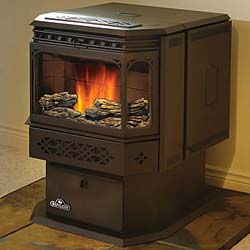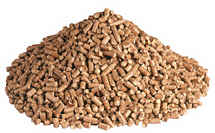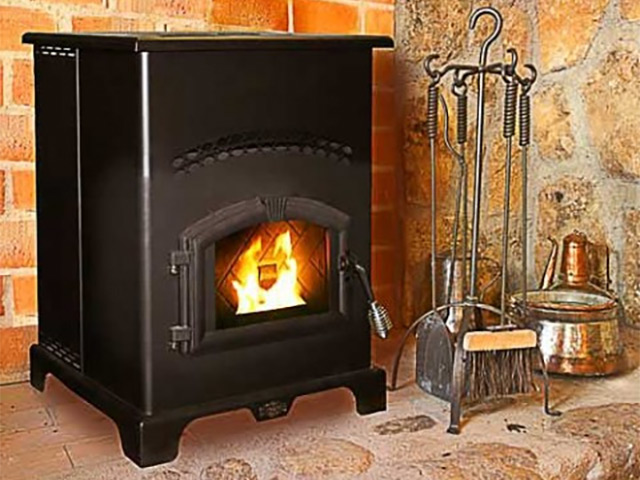Jun 18th 2020
All About Pellet Stoves
What Are Pellet Stoves
On the outside, pellet stoves look a lot like wood stoves but internally, they are very different and are built with more sophisticated parts and components. Pellet stoves are heating appliances that burn compressed wood or biomass pellets to create a source of heat. By slowly feeding fuel from a storage container otherwise known as a hopper, into a burn-pot area, they create a constant flame that requires little to no physical adjustments.
Pellet stoves generally consist of a hopper, an auger system, two blower fans, a firebox, various safety features and a main control box. To properly function, pellet stoves require the use of electricity and can be plugged into a normal wall outlet. Fan systems on pellet stoves are necessary for a clean, economical performance.

How do Pellet Stoves Work
Unlike wood stoves which operate exclusively on a principle of chimney draft, pellet stoves must use specially sealed exhaust pipe to prevent exhaust gases from escaping into the living space due to the air pressure produced by a combustion blower. Pellet stoves require certified double-wall venting, normally three or four inches in diameter with a stainless steel interior wall and a galvanized outer wall.
Pellet stoves are fueled by loading wood pellets into a device called the hopper. The hopper size will vary from stove to stove but think of it just like you would BTU's on a wood burning stove. The higher the BTU range, the more powerful the wood stove is and the longer it will provide heat. Just like with a pellet stove, a bigger hopper will hold more wood pellets and provide longer periods of heat for your home.
Some pellet stoves are equipped with automatic lighting while others will require you to light the stove. Once the wood pellets have been loaded into the hopper, the pellet stove will transfer the pellets into a heating chamber on a controlled and automatic system, using an internal thermostat to gauge the heat and alert you when it's time to reload more pellets. Room air is then sucked into the pellet stove through a built-in fan, transferred through the heating chamber, and distributed back into the room as heated air.
Pellet Stove Feeds
Pellet stoves require one of two types of feeds to transfer wood pellets to the combustion chamber where they are burned. Inside of the pellet stove there is a device called an auger that carries the pellets into the combustion chamber. The two types of pellet feeds include:
-
Top feed - Top feeds on a pellet stove use the auger system to carry pellets to the combustion chamber from the top of the stove. Top feeds reduce the risk of a fire burning back into the hopper. The down side to the top feeding method is that ash may get caught up in the firebox grate which can build up and cause the fire to die down. As a result, many manufacturers of top-fed models recommend burning high-grade, low-ash pellets
-
Bottom feed - A bottom feed on a pellet stove carries the wood pellets to the combustion chamber on a horizontal auger system. When a pellet stove uses a horizontal auger system, ash is pushed to the sides where it falls into the ash pan making cleaning and maintenance easier and safer. With bottom feed pellet stoves you will have to remove the ashes about once a week.
Wood Pellets
Wood pellets are a natural resource that comes from left over materials that are made from wood. Wood pellets most commonly come from resources like wood mills, furniture stores, recycling centers, roadside scrap, nuts, sawdust, logging residue, and paper packing plants. Pellet manufacturers will dry the wood scraps to a 20 percent or less moisture level, compress them, and form them into small cylinder shaped pieces of wood that are similar to the look and size of rabbit food pellets.
There are two different types of wood pellets that can be used with pellet stoves including standard wood pellets and premium grade wood pellets. Premium grade wood stove pellets have less inorganic ash than the standard grade wood stove pellets do meaning less ash and more heat for your money. Pellet fuel is normally sold in 40 pound (18 kg) bags at about $3-$4 each, or about $120-$200 a ton. You can estimate how much fuel you will need for a heating season by noting that one ton of pellets is equivalent to approximately 1.5 full cords of firewood.

Pellet Stove Benefits
-
Pellet stoves are very easy low-maintenance appliances to heat your home with. Typically you will only need to reload your pellet stove hopper every one to two days depending on the size of your hopper. Wood pellet stoves eliminate messy wood splitting and firewood hauling sessions. All you have to do to load your pellet stove is simply pour the wood pellets from the bag or your pellet bucket or container into the hopper.
-
Since pellet stoves use dried wood pellets they do not produce any smoke. With a pellet stove you will never have to worry about being smoked out of the room or breathing in the smoke and fumes which could be hazardous to your health. Wood pellets also operate without drying out the air in your home.
-
Pellet stoves are a great option for homeowners that have pets or small children. Since pellet stoves produce virtually no exterior heat and remain cool to the touch, they are safe to operate around pets and children. This also allows you to place your wood pellet stove as close as 1" away from the wall opening up more installation possibilities.
-
Pellet stoves are extremely environmentally friendly considering that they use recycled materials that burn in an Eco friendly manner. Pellet stoves operate using renewable energy which is readily available. They release less harmful gases into the air and no trees are cut just to manufacture them.
Pellet stoves are clean-burning, low-cost and low maintenance stoves that are becoming increasingly popular among homeowners who are concerned with rising fuel costs, our independence from overseas resources, and our environment. Pellet stoves can be just as effective and efficient as wood burning stoves and some of them are manufactured to easily integrate into your home's current vent system so that you are able to heat your entire house. Pellet stoves also make great zone heaters if you don't need a heating appliance to heat your entire home.


